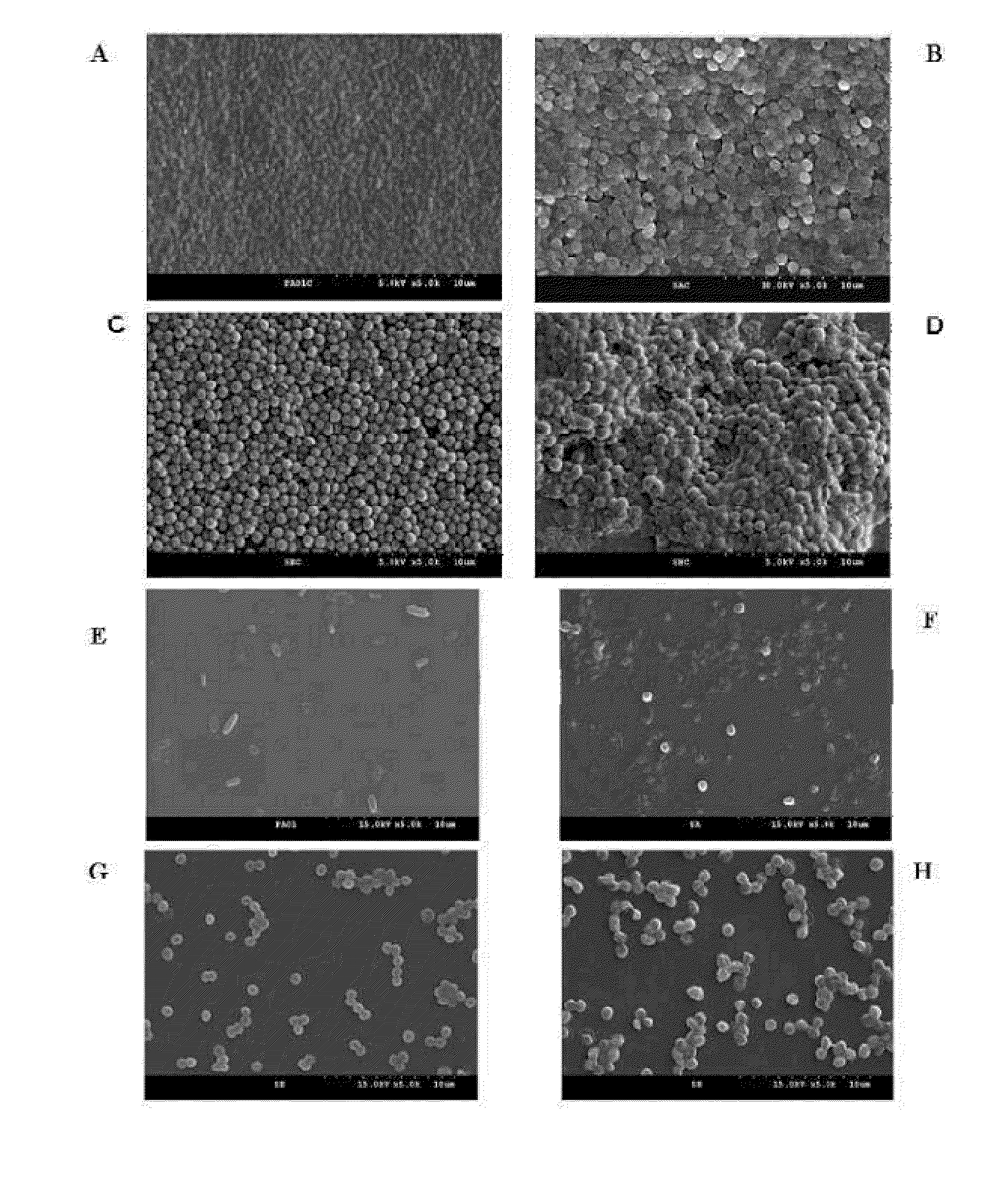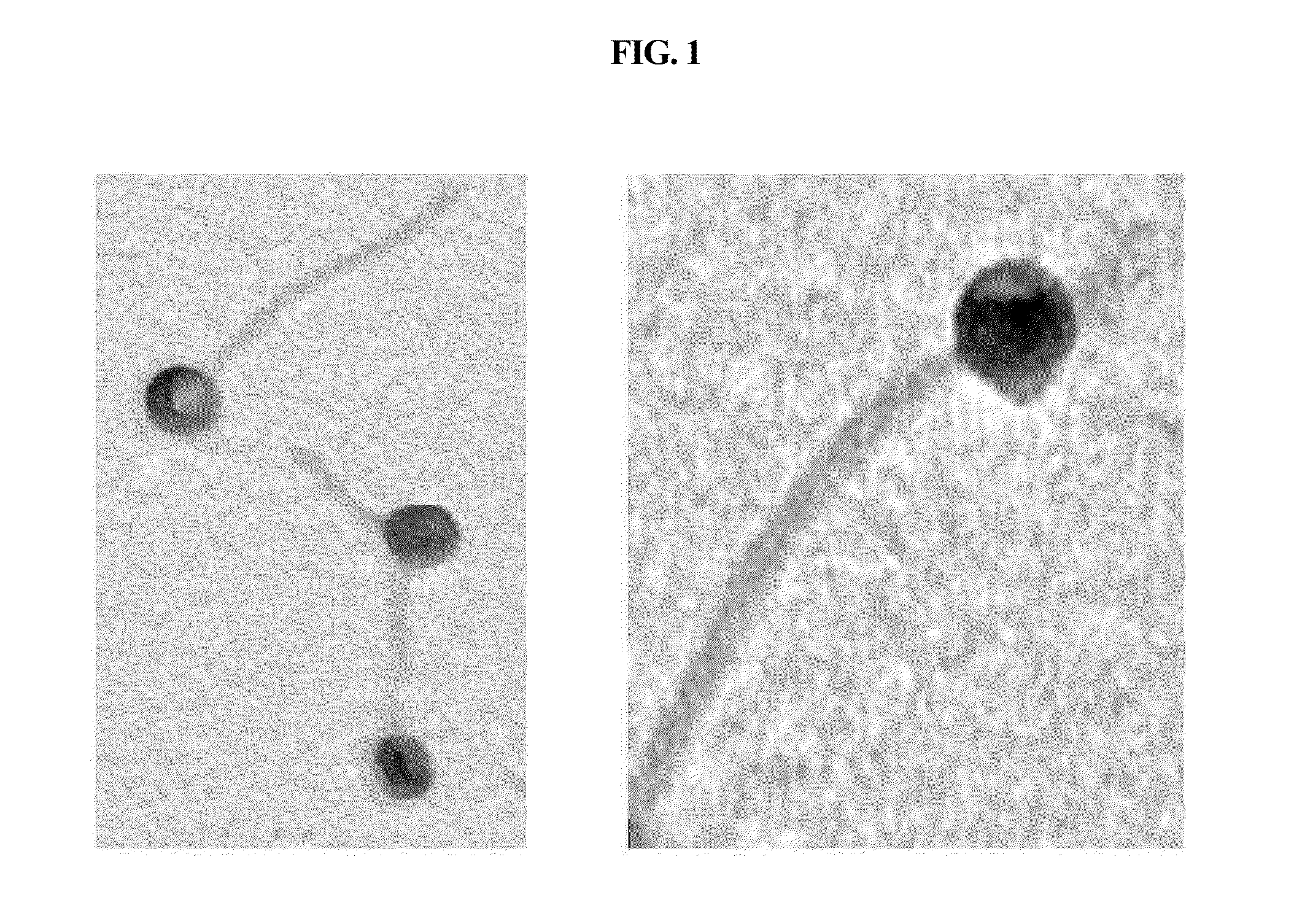Bacteriophage killing pseudomonas aeruginosa and staphylococcus aureus
a technology of staphylococcus aureus and pseudomonas aeruginosa, which is applied in the field of bacteriophage killing pseudomonas aeruginosa and staphylococcus aureus, can solve the problems of affecting the immune system, bacterium may attack injured sites, and patients may be fatally affected, so as to reduce the causative bacteria in food stuffs or environment, avoid the effect of contaminating the environment and low cos
- Summary
- Abstract
- Description
- Claims
- Application Information
AI Technical Summary
Benefits of technology
Problems solved by technology
Method used
Image
Examples
example 2
Host Specificity and Killing Ability of Bacteriophage PA1Φ Against Various Bacteria
[0049]The bacteriophage solution obtained in Example 1 was used. Various bacteria including Pseudomonas aeruginosa cultivated in nutrient media were shaking-cultivated for an hour and spread onto nutrient agar plates. Then, the solution containing the bacteriophage PA1Φ was dropped onto the bacterial lawn and incubated at 37° C. for 18 hours. Afterward, degrees of cell lysis were observed. The killing ability of bacteriophage PA1Φ against each bacterium is summarized below in Table 1.
TABLE 1Host specificity of bacteriophage PA1ΦBacteriaPseudomonas aeruginosakilled by(ATCC 29853, ATCC 15692)bacteriophageStaphylococcus aureusPA1Φ(ATCC 25923, ATCC 29213)Clinically-isolated strainClinically-isolated strainCoagulase-negativeClinically-isolated strainBacteriaEscherichia coli (ATCC 25922)without beingEnterobacter aerogeneskilled byClinically-isolated strainbacteriophageAcinetobacter baumanniiPA1ΦClinically- ...
example 3
Morphological Observation of Bacteriophage PA1Φ by Electron Microscopy
[0051]In order to observe the bacteriophage PA1Φ morphologically, electron microscopy was conducted. About 1012 PFU of purified bacteriophages were overlaid onto carbon-coated copper grids and negatively stained with 2% uranyl acetate. Electron microscope images of the bacteriophage PA1Φ were taken using a Phillips EM 300 transmission electron microscope.
[0052]As a consequence, the bacteriophage PA1Φ was observed to have an iscosahedral head and a long tail. Due to the morphological features, the bacteriophage PA1Φ has been classified to Siphoviridae family.
example 4
Genetic Characteristics of the Bacteriophage PA1Φ
[0053]Genome of the bacteriophage PA1Φ was prepared by using a Lambda midikit (Quiagen). The resulting genome of the bacteriophage PA1Φ was delivered to Macrogen Co. Ltd. in order to determine the sequences of whole genome. In order to determine the total nucleotide sequences, shotgun cloning was performed, further cosmid libraries were constructed and analyzed by using an automatic sequence analyzer (ABI PRISM 377). From the sequencing data, open reading frames (ORF) were analyzed by using Sequin software version 9.5. As a result, it is found that the genome of the bacteriophage is double-stranded DNA having about 34.5 kbp of size (SEQ ID NO: 1) and is composed of 51 ORFs (See FIG. 5). Besides, the total nucleotide sequence was analyzed by using a BLAST program, NCBI, US. Consequently, it was determined to have 97% and 90% of homology respectively with MP29 and D3112 bacteriophages, both specific for Pseudomonas aeruginosa, and ident...
PUM
| Property | Measurement | Unit |
|---|---|---|
| pH | aaaaa | aaaaa |
| anti-bacterial resistance | aaaaa | aaaaa |
| time | aaaaa | aaaaa |
Abstract
Description
Claims
Application Information
 Login to View More
Login to View More - R&D
- Intellectual Property
- Life Sciences
- Materials
- Tech Scout
- Unparalleled Data Quality
- Higher Quality Content
- 60% Fewer Hallucinations
Browse by: Latest US Patents, China's latest patents, Technical Efficacy Thesaurus, Application Domain, Technology Topic, Popular Technical Reports.
© 2025 PatSnap. All rights reserved.Legal|Privacy policy|Modern Slavery Act Transparency Statement|Sitemap|About US| Contact US: help@patsnap.com



